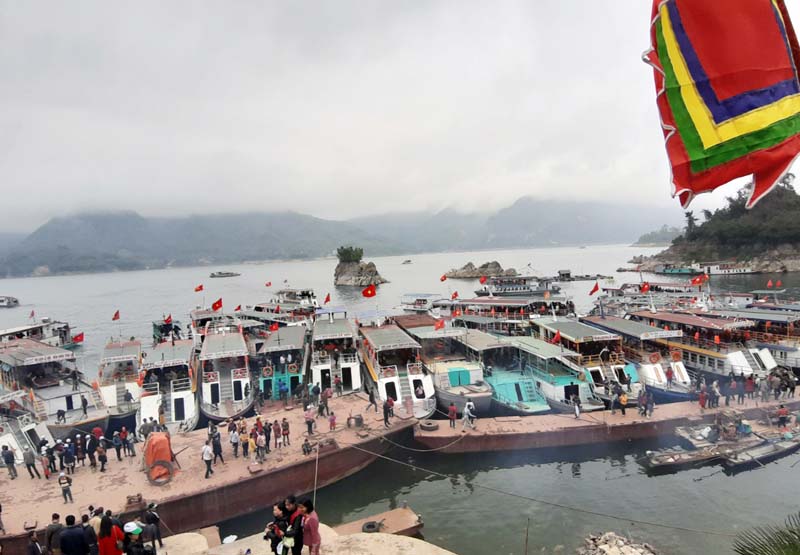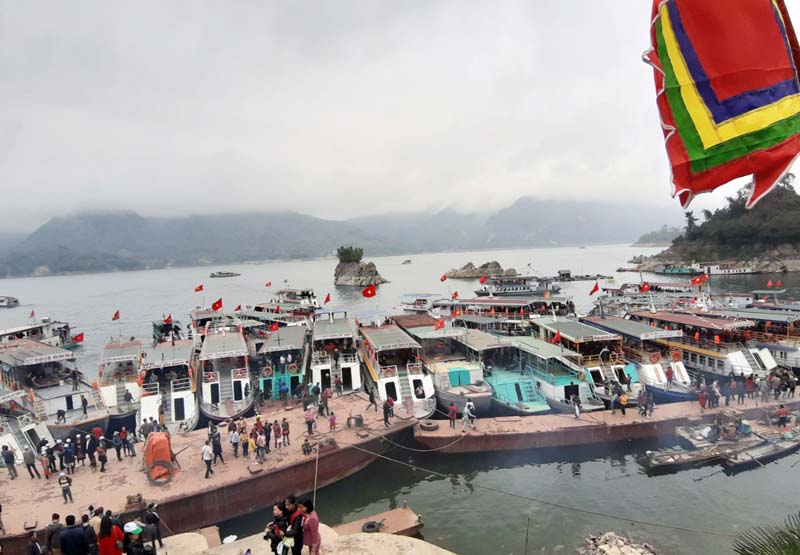
(HBO) – Hoa Binh Lake is a relatively perfect combination of the nature and cultural identifies of local residents, becoming a magnet for both tourists and investors.

Thac Bo Temple on Hoa Binh Lake is a
spiritual tourism attraction for a large number of visitors.
Covering an area of 2,249
sq.km, the 70km-long lake spreads across many communes of five district-level
localities. It is home to numerous spectacular and poetic islets such as those
in Thung Nai commune (Cao Phong district) and Tien Phong commune (Da Bac
district).
Apart from the charming
natural beauty, Hoa Binh Lake also boasts a vast and unique cultural space of
the Muong, Tay, Dao, and Thai ethnic minority groups that promises fresh
experiences for tourists.
Given the lake’s special
potential, the Prime Minister approved a master plan on the development of the Hoa
Binh Lake national tourism area in Hoa Binh province until 2030. To carry out
the PM’s decision, the provincial Party Committee issued a resolution on the
development of the Hoa Binh Lake tourism area into a national one. Following
that, a detailed plan was launched by the provincial People’s Committee to
implement the resolution, featuring such activities as attracting resources for
investment infrastructure, stepping up investment promotion, and developing
tourism products in line with the master plan.
Hoa Binh Lake was identified
as a key tourism area in the province, focusing on high-quality tourism
associated with environmental protection.
Provincial authorities are
working to attract potential businesses to developing high-quality tourism
products that generate high added value and help fuel sustainable economic
restructuring. They are also directing sectors and localities to boost the creation
of ecological, resort, and cultural tourism products; the popularisation of the
lake’s image; personnel training; the connection of tours; the mobilisation of
resources for tourism infrastructure construction; and the development of
environmentally friendly tourism products imbued with local cultural identities,
thereby adding to the attractiveness of Hoa Binh Lake.
Spanning thousands of hectares and winding gracefully along mountain slopes, hillsides, and riverbanks, the terraced rice fields of Lac Son District present a stunning and captivating beauty. This region, renowned for its remarkable terraced landscapes, is also the centre of Hoa Binh Culture known for numerous archaeological sites.
The life of Mong people in Hang Kia and Pa Co communes of Mai Chau district has improved much thanks to tourism development.
The man-made Hoa Binh Lake, with a water surface area of approximately 9,000 hectares and a capacity of 9.45 billion cubic meters, stretches over 200 kilometers from Hoa Binh to Son La provinces. With the goal of developing into a national tourism area, the Hoa Binh Lake tourism area is expected to not only become the largest tourism centre in the province but also one of the 12 key tourist destinations in the northern midland and mountainous region of Vietnam.
Da Bia hamlet, now Duc Phong, in Tien Phong commune, Da Bac district, was once almost isolated from the outside as the only way to the hamlet was to get a boat ride across the Hoa Binh reservoir. However, as its tourism potential has been unleashed, the hamlet has established itself as one of the most attractive destinations on the tourism map. It has even received the ASEAN Community-Based Tourism Awards in 2019.
In the first 9 months of 2024, Mai Chau district, Hoa Binh province welcomed over 684 thousand visitors to visit and relax. In which, over 516 thousand domestic visitors and more than 168 thousand international visitors. Total revenue from tourism is estimated at over 821 billion VND.
Da Bac district, bestowed with stunning landscapes, is developing ecological and resort tourism offerings. Several tourist sites, put into operation this year, has attracted throngs of high-spending and young domestic visitors.



